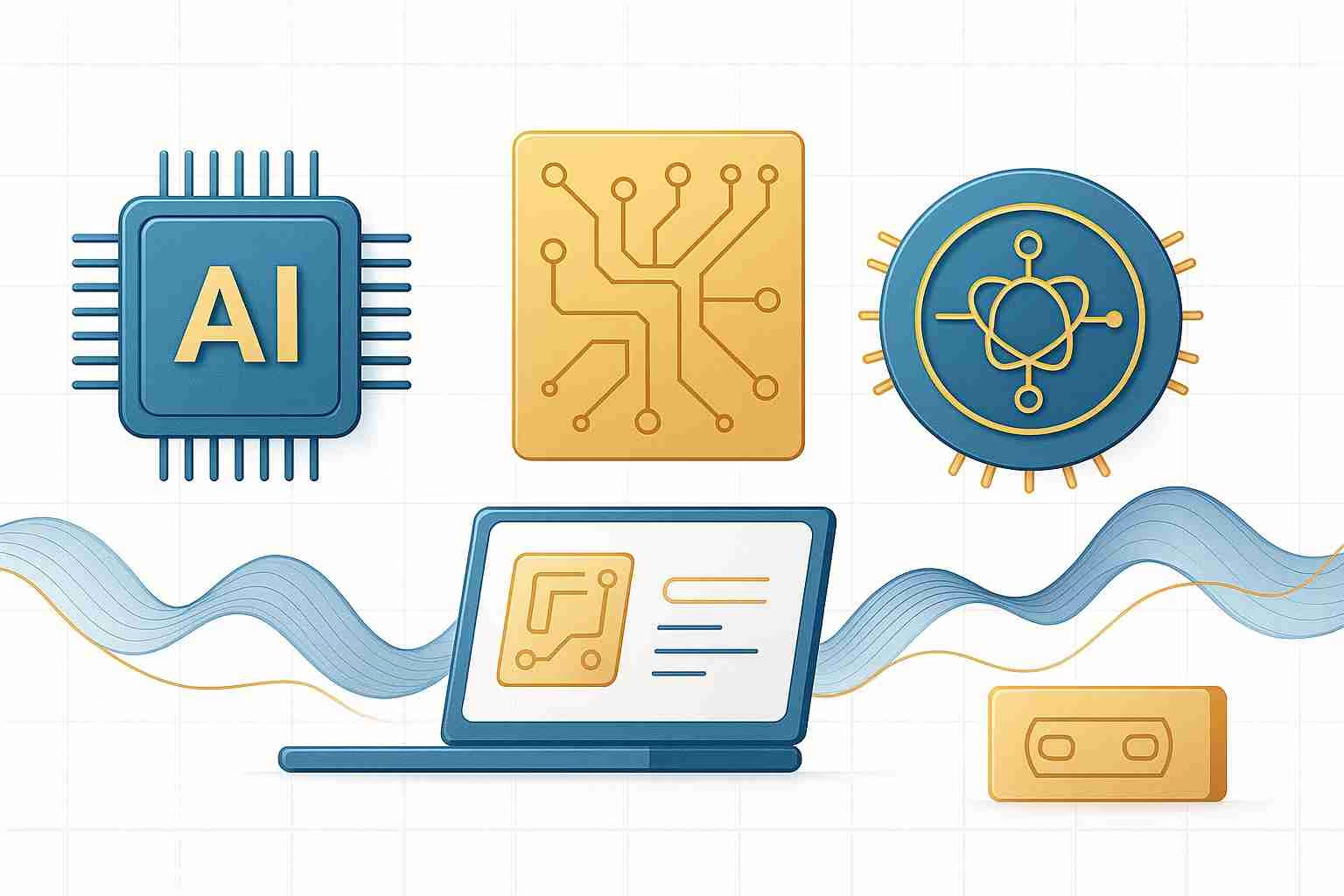5 Breakthrough AI Hardware Startups to Watch in 2025: Powering the Next Gen of Intelligence

5 Breakthrough AI Hardware Startups to Watch in 2025: Powering the Next Gen of Intelligence
The AI Hardware Revolution
Artificial intelligence is transforming industries, but its potential is bottlenecked by traditional computing hardware. In 2025, AI hardware startups are at the forefront, securing over $10 billion in venture capital to develop chips, accelerators, and quantum systems optimized for AI workloads. These advancements are critical for scaling generative AI, edge computing, and real-time analytics. According to PitchBook, AI hardware funding surged 45% in 2024, reflecting investor confidence in specialized silicon and photonic solutions. BytesWall dives into five startups leading this charge, offering insights into their technologies, market impact, and why they’re poised to shape AI’s future.
1. Cerebras Systems
Massive Chips for Massive AI
Cerebras Systems is redefining AI hardware with its Wafer-Scale Engine 3 (WSE-3), the world’s largest chip, boasting 4 trillion transistors and 900,000 cores. This behemoth accelerates AI training by up to 10x compared to GPUs, enabling hyperscalers like Google and Meta to process massive datasets. In 2024, Cerebras raised $720 million at a $4 billion valuation, with backing from NVIDIA and Intel Capital. Its technology is pivotal for scientific AI, reducing training times for models like Llama 3 from weeks to days.
Why It Matters: Cerebras’ chips address the compute bottleneck in AI, enabling faster innovation in healthcare, climate modeling, and more. Its partnerships with national labs signal broad adoption.
Actionable Takeaway: Follow Cerebras’ blog for updates on WSE-3 applications and explore their open-source AI training tools on GitHub.
2. D-Matrix
Efficiency for Edge AI
D-Matrix specializes in energy-efficient chips for AI inference, critical for edge devices like autonomous vehicles and IoT sensors. Its Corsair platform delivers 10x performance per watt compared to traditional GPUs, addressing the power constraints of edge computing. Raising $110 million in 2025 at a $1.5 billion valuation, D-Matrix counts Microsoft and AMD as investors. Its chips are deployed in smart cities, reducing latency for real-time AI.
Why It Matters: With edge AI expected to grow 30% annually (Gartner, 2025), D-Matrix’s efficiency makes AI accessible beyond data centers.
Actionable Takeaway: Experiment with D-Matrix’s inference SDK (free tier) and share your edge AI project on X with #AIHardware2025.
3. Lightmatter
Photonic Computing for AI
Lightmatter leverages photonics to build light-based AI chips, slashing power consumption by 90% compared to silicon GPUs. Its Passage chip integrates optics and silicon, accelerating AI workloads for cloud providers. Securing $400 million in 2025 at a $3 billion valuation, Lightmatter is backed by Google Ventures and Sequoia. Its technology is ideal for sustainable AI, addressing the 10% of global electricity AI data centers consume (IEA, 2025).
Why It Matters: Photonic computing offers a greener path for AI scaling, critical as environmental regulations tighten.
Actionable Takeaway: Read Lightmatter’s whitepapers on Lightmatter.co and join their webinar series for photonic AI insights.
4. SambaNova Systems
Full-Stack AI Platforms
SambaNova Systems delivers full-stack AI platforms, combining custom chips with software for enterprise AI. Its DataScale systems power generative AI for companies like Salesforce, achieving 5x faster inference. Valued at $5 billion after a $1 billion raise in 2024, SambaNova’s integrated approach simplifies AI deployment. Its chips optimize large language models, reducing costs by 30% (Forrester, 2025).
Why It Matters: Enterprises need turnkey AI solutions, and SambaNova’s platforms bridge hardware and software gaps.
Actionable Takeaway: Explore SambaNova’s free trial for DataScale and network with enterprise AI pros on LinkedIn.
5. PsiQuantum
Quantum AI Accelerators
PsiQuantum is building photonic quantum computers for AI, targeting million-qubit systems by 2027. Its chips promise exponential speedups for AI tasks like optimization and drug discovery. Raising $450 million in 2025 at a $3.5 billion valuation, PsiQuantum is backed by BlackRock and Baillie Gifford. Its quantum approach could revolutionize AI model training, cutting compute costs by 40% (McKinsey, 2025).
Why It Matters: Quantum computing is the next frontier for AI, unlocking complex problems unsolvable by classical hardware.
Actionable Takeaway: Take Coursera’s “Quantum Computing Basics” (free audit, ~10 hours) and follow PsiQuantum’s blog for updates.
Why These Startups Are Critical for AI’s Future
AI’s exponential growth—projected to contribute $15 trillion to the global economy by 2030 (PwC)—relies on hardware breakthroughs. These startups are tackling compute bottlenecks, energy inefficiency, and scalability with massive chips, photonic processors, and quantum accelerators. With $3.2 billion in 2025 funding (PitchBook), they’re backed by NVIDIA, Intel Capital, and Sequoia, reflecting strong market confidence. Their innovations enable faster AI training, greener data centers, and edge deployment, while addressing regulatory pressures on energy and ethics. As AI adoption accelerates, these companies are set to redefine computing.
Industry Trends for 2025:
- Energy Efficiency: AI hardware must cut power use as data centers face scrutiny (IEA, 2025).
- Edge AI Growth: 60% of AI workloads will run on edge devices by 2027 (Gartner).
- Quantum Leap: Early quantum AI applications will emerge in finance and pharma by 2026 (McKinsey).
How to Engage with AI Hardware in 2025
Want to dive into AI hardware? Here’s a 30-day roadmap to get started:
- Week 1: Learn AI hardware basics with Coursera’s “AI and Hardware” (free audit, ~8 hours).
- Week 2: Experiment with Cerebras’ open-source tools or D-Matrix’s inference SDK.
- Week 3: Join r/MachineLearning on Reddit to discuss AI hardware trends.
- Week 4: Attend a virtual AI hardware summit (e.g., Hot Chips, ~$100) and share insights on X with #AIHardware2025.
Pro Tip: Build a GitHub portfolio with an AI hardware project (e.g., edge inference demo) to attract recruiters.
Ready for the AI hardware revolution? Track these startups and explore cutting-edge tech at BytesWall.com.




